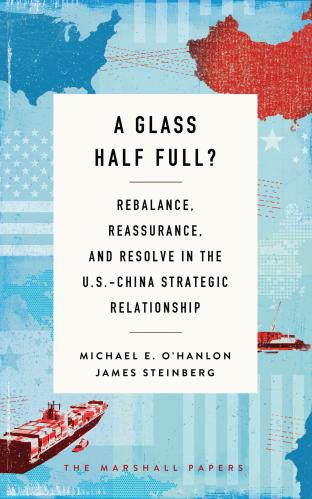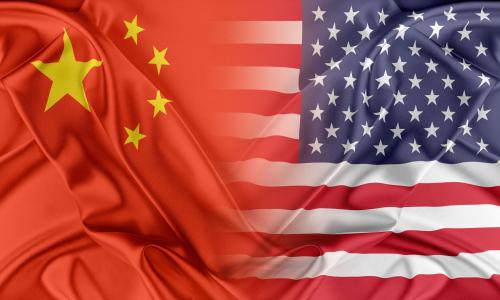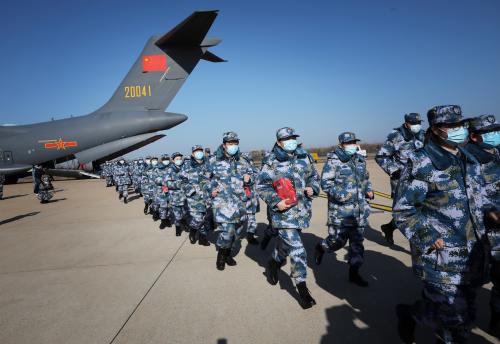The EU-China Summit this week made clear that while both the United States and Europe are both moving toward a tougher and more critical view of China, European governments aren’t anywhere near as tough. Instead, they are trying to advance their distinct interests, which means emphasizing cooperation and partnership with China along with vigorous competition and criticism.
Understanding our allies’ approaches to China is important because virtually every critique of President Donald Trump’s foreign policy charges that his administration acts “unilaterally” and that we should be “working with our allies.” Whenever presumptive Democratic presidential nominee Joe Biden discusses foreign policy, he is explicit that working with our allies will be a pillar of his approach, including on China policy. And rightly so — the U.S. will be much stronger and have greater leverage in addressing China if we develop and execute policies jointly with our allies and friends.
But what common policies are possible? We can’t work on a collaborative approach towards China unless we first understand how our allies see and act on their own interests. We need to be as clear-eyed as possible, not cherry-picking European viewpoints that match our own and misperceiving what collaborations with Europe are realistic. And we will need to take European interests into account as we work with them to forge collaborative policies and actions.
Partnership and rivalry
This week’s EU-China summit indicates both the potential and the challenges of trans-Atlantic collaboration on China. Europe’s position towards China has toughened. But the official EU statement issued after the summit is headlined: “EU-China Summit: Defending EU interests and values in a complex and vital partnership.” The word “partnership” has basically disappeared in U.S. policy and most policy debates about China, replaced by “competition,” “rivalry,” even “confrontation.” The nuanced U.S. policy advocates add various degrees of “cooperation,” while others omit that word altogether. Yes, the EU’s headlined “partnership” with China is labelled “complex” and requires “defending EU interests and values,” but partnership with China is still seen as “vital.”
In the Q&A after her press conference statement, EU Commission President Ursula von der Leyen also referred specifically to the March 2019 EU Commission document titled: “EU-China: A strategic outlook.” It is the most important recent statement of EU policy, and clearly signaled the sharper EU approach to China, but it describes the EU-China relationship in a multifaceted way:
China is, simultaneously, in different policy areas, a cooperation partner with whom the EU has closely aligned objectives, a negotiating partner with whom the EU needs to find a balance of interests, an economic competitor in the pursuit of technological leadership, and a systemic rival promoting alternative models of governance. This requires a flexible and pragmatic whole-of-EU approach enabling a principled defence of interests and values.
Many observers have correctly underscored the “systemic rival” concept as an importantly new and much tougher way the EU describes China. But too many observers have ignored the other concepts that the EU embraces in the very same sentence: “cooperation partner,” “negotiating partner,” and “economic competitor.” Von der Leyen confirmed that this multifaceted strategy remains the EU approach, and indeed we saw this complex approach in action this week. The official EU statements after the summit were tough on several subjects — most importantly, the economic relationship with China and human rights — and on others struck a more cooperative tone.
The interests at stake
Economic issues are clearly a top interest for Europe. The Europeans’ increasing toughness on trade and investment largely overlaps with U.S. concerns: China’s unfair and non-reciprocal economic behavior regarding market access; its state-owned enterprises and subsidies; its multi-faceted efforts to acquire ownership of European high technology; and the need to have rules-based governance of these economic areas. EU leaders expressed repeated impatience with slow progress in multi-year negotiations with China on a comprehensive investment agreement. Both the EU and China spoke of trying to conclude a deal “by the end of the year,” but as the EU leaders said rather euphemistically, this will require “more ambition on the Chinese side.”
Concrete collaboration between the U.S. and Europe would generate more leverage in changing China’s unfair economic practices. Important opportunities exist to jointly push shared economic interests, including on China’s subsidies, protecting cutting-edge high technology and intellectual property, government procurement policies, market access to China, evening the playing field within China, harmonizing rules on inbound investment, WTO reform, and even considering new multilateral high standards trade entities.
The EU also used strong language about human rights, Beijing’s imminent National Security Law for Hong Kong, Xinjiang, Tibet, and arbitrary detentions of named individuals. The EU has also been underscoring challenges to democracies arising from authoritarian systems — China, as well as the even more direct intrusions by Russia. These are areas where Europe has been significantly toughening its approach and where closer collaboration between the U.S. and Europe could put more effective pressure on China..
EU leaders also expressed concern about maintaining “the rules-based international system” and multilateral approaches, inappropriate “Chinese influence” and “disinformation” activities, and “adhering to international standards to support sustainable development.” These are other areas where the U.S. and Europe can and should be working together closely. Updating and strengthening the rules-based international system is especially important. If a new U.S. president is elected in November, there are likely large opportunities to work with Europe on pushing for updated international institutions that reflect our shared ideas and pushing back on Chinese proposals that we oppose.
At the same time, the EU leaders underscored that “engaging and cooperating with China is both an opportunity and necessity.” They noted that Europe and China have been working together on COVID-19, climate change, and to some extent on sustainable development. They underscored that “economic interdependency is high,” with both shared benefits and problems.
What Washington should do
From all of this, it seems clear that the U.S. can and should work with our European allies in various areas related to China, perhaps most importantly trade and investment issues, human rights, and updating the international system in ways that reflect our values and interests and opposing inappropriate changes that China is pushing.
But there are problems in developing a collaborative approach with the Europeans, and we need to see these clearly. As things currently stand, U.S. and European interests related to China hardly converge across the board. Indeed there are significant differences among different European countries, which China has been exploiting. Nor have European policymakers followed the U.S. in starkly shifting their approach away from cooperation with China. To be sure, debates about China policy are now vigorous in Europe. COVID-19 and “wolf warrior” diplomacy have hurt perceptions of China among many Europeans, and COVID-19 has also affected European worldviews more generally. Europe’s trend toward a tougher approach to China may accelerate and move closer to that of the United States.
Nevertheless, significantly diverging interests exist and will almost certainly remain, so working with Europe on a joint China policy will have to deal head-on with realities such as these:
- Europe is far more dependent on trade and investment with China than the U.S. is. China is the EU’s second largest trading partner, and the EU is China’s biggest trading partner. Europe sees its interests as maintaining good economic relations with both the United States and China, definitely not choosing between them. So Europe is highly unlikely to jeopardize its beneficial economic relationship with China even as it pushes hard for fair competition. Furthermore, the U.S. and the EU are themselves tough economic competitors, with major complaints and lawsuits coming from both sides.
- Europe does not share the United States’ superpower focus on geopolitics and intense national security concerns related to the Indo-Pacific. Europe sees its interests in Asia overwhelmingly in economic terms, and will provide little support to our military activities there.
- Europe’s increasingly strong public objections to China’s human rights policies are unlikely to go beyond words. At the summit, EU leaders had particularly strong words about Hong Kong, but did not call for sanctions on China that other Europeans and human rights groups have called for, and that the U.S. Congress supports. Instead, what they said was that Europe was “standing firm on [its] values,” and that it “will always raise [its] concerns … and insist on having [its] views on these topics.” Europe has good ties with Taiwan, but has shown little inclination to press the boundaries of its longtime “One China” policy, which the U.S. has been doing.
- The EU and European countries continue to embrace cooperation with China alongside their articulated differences and their announced systemic rivalry in models of governance. They work together on climate change within the Paris Accords, even as Europe presses China hard to do more; they’ve been cooperating on COVID-19 country-by-country and through the World Health Organization; and European parties to the Iran nuclear deal have continued to work with China on that. In spite of China’s problematic behavior, the rhetoric of Europe’s leaders does not attack China as a confrontational, unyielding, or punitive country. (The video of President Ursula von der Leyen’s post-summit press conference is worth watching for its tone as much as for its content.) In contrast to Europe’s seemingly strong commitment to cooperation with China in meeting global challenges, President Trump is all out, and Democrats seem divided.
- After almost four years of the Trump administration, our European allies and Europeans more generally are extremely distrustful of the United States. This president has frequently expressed annoyance or even hostility towards Europe, and Washington is perceived as unreliable and unpredictable. If Biden is elected president, he will almost certainly want to restore the lost trust among Europeans. But that won’t be easy to do and will take time, skilled diplomacy, and a type of American leadership that includes listening, negotiating, and even compromising with our allies and friends if we want to work effectively with them.
This week’s EU-China Summit was just a moment in a rapidly evolving process as the world adjusts to a newly powerful China in a climate of huge unknowabilities. But we do know that the United States will be better off if we approach China with the strength that comes not only from our own domestic resilience but also from working collaboratively with our allies and friends — and they will be better off too.










Commentary
The future of trans-Atlantic collaboration on China: What the EU-China summit showed
June 26, 2020